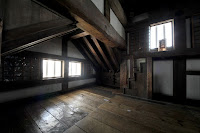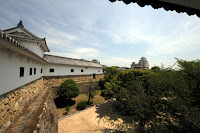Today we got our castle fix in the best way possible. Hans had been telling me about this place in the months leading up to this trip so we were both looking forward to seeing it in person.
First, a quick note about train travel in Japan. For our longer distance rail journeys we've been traveling on Japan's fastest trains: Shinkansen! Our rail passes do not allow us to ride on the flagship Nozomi trains that make the fewest number of stops but we've been on the Hikari trains that still travel at a top speed of 300 kph. The ride is so absolutely smooth you almost don't notice.
Anyway Himeji's train station is about 2 km from the castle, which is impossible to miss from the lofty perch that rises up from the relatively flat city. Also called the White Heron Castle, Himeji is one of the most significant wooden buildings in Japan. It was the first place in Japan to be registered as a UNESCO World Cultural Heritage site. The original main keep was built in 1580. Additional floors were added during subsequent decades. It was upgraded to today's seven floors in 1609.
Climbing the hill to the entrance
The main keep
When we reached the visitor's entrance to the main keep we were provided with plastic bags to put our shoes in. With all of the wood flooring it's understandable that they want to preserve it as much as possible. I liked how the signs telling everyone to take off their shoes put a positive spin on the directive: "Samurai used to walk these halls in bare feet. Feel what it was like for them!"
The basement level. In the back of the left photo you can see one of the two main pillars that support all seven levels of the keep. We had to climb up many steep and sketchy staircases but the elderly castle volunteer who kindly gave Hans and I a private tour made it look easy.
The castle gives visitors an idea of what Japanese warfare would have been like hundreds of years ago. There were many rifle racks in the halls waiting to be fired through holes in the defensive walls. Around the perimeter of some floors there were skinny trap doors called "stone drops". Our tour guide said that European tourists often guess that the trap doors are for pouring boiling oil but that only works if your castle is made of stone! Himeiji is made of an elaborate wooden framework and heavy plaster. That fact alone is why it is amazing that the castle is still around today.
Japan has invested heavily in restoration of and upgrades to the structure over the years. The "Showa Era Restoration" took place in 1934. Miraculously, the building was unscathed by WWII during the next decade despite the air raids Himeji City endured. The "Heisei Era Restoration" took place from 2009 to 2015. During these restorations several floors of the main keep were deconstructed down to the wood frame and re-plastered. Roof tiles were secured with more modern building materials.
A scale model of the keep's timber frame. Interestingly, in the event of an earthquake the frame is designed to allow parts to shake independently of each other and therefore reduce the possibility of structural failure. We're talking about 1600's construction!
Looking out onto the West Bailey
Over the centuries the castle grounds were expanded with additional defensive walls and moats. Today only the inner moat can be seen however at the castle's peak land coverage the third and outermost moat ran where today's train station is, seen at the far end of the main road in the above photo. That's nearly two kilometers away! The decorative figures on the roof are in the shape of a mythological creature that has the tail of a tiger and head of a carp. Sachihoko are believed to bring rain and so they often decorate old Japanese buildings in order to prevent fire.
Inside the West Bailey, one room had it's interior finished
Different generations of Sachihoko, newest to oldest from left to right
Himeiji's nickname of the "White Heron" is well deserved however I fell in love with the castle's PR mascot that can be seen all over town and in local gift shops: Princess Shiromaru!
Is she not the cutest?
After a quick lunch on our way back to the train station we collected our suitcases from the storage lockers and waited for our train. During this time a Shinkansen ran along the rails overhead and at speed without stopping. It was upsettingly loud and shook the whole building (or so it seemed). If it weren't for the fact that everyone else and the station didn't seem to notice I would have ducked and covered. Our train connection in Kobe was ten minutes but Shin-Kobe station only has two platforms so we navigated without a sweat. We arrived in Hiroshima but took their subway to the pier for the ferry to Miyajima Island, one of Japan's most favorite places to visit.
As we approached the island its iconic Itsukushima Shrine and famous "floating" torii gate glowed in the afternoon sun. More about those in later posts.
Since we're rapidly approaching the end of our vacation, it is time to slow things down. We were picked up at the pier by a shuttle van for our next accommodation: A traditional Japanese inn, called a ryokan. The one we were staying at is over a hundred years old and has been synonymous with Japanese hospitality on Miyajima. The oldest buildings on the property are individual cottages that were built in the early 1900s. We would be staying in the newer hotel-y building but that didn't make our room any less appreciated. We would be staying on the top floor with views of both the mountainside and the sea. And we could hear the stream at the bottom of the valley even with the windows closed. The maid who was assigned to our room explained the "rules" and how the hotel is run. Each day we would tell them at what time we'd like to eat dinner and then Hans and I would dress in yukata robes and sit on the floor as we were served a nine course meal!
The presentation was absolutely impeccable though sometimes we were challenged by some of the weirder foods. One of the courses came with a crayfish head. When I went to remove the meat all of the antennae and eyes came with it and then I panicked as our maid was coming into the room with the next course. I didn't want to appear rude by leaving food behind so I hurriedly stuffed it into my mouth and uncomfortably crunched through the antennae and tried not to think about the eyeballs. I survived.
Sea view, check. Private veranda, check.
I swear we didn't drink that much sake!
Pretty plates and presentation
After the meal we were asked what time we wanted the room set up for sleeping. We decided to go for a walk and told them they could start at any time. The tide was nearly at it's low point so we decided to use the opportunity to get up close to the floating torii gate. As we were wandering around I walked right through someone's long exposure shot. After I apologized the friendly German photographer struck up a conversation with us. We compared travel notes and then she asked for advice on night photography since she was new to the hobby. I gave her a little 10-minute lesson and then we hung out at the low tide trying different types of camera settings. At the end of the night I realized that I hadn't actually walked up to the gate but Hans did and he got some really interesting pictures.
People had left coins in between the barnacles on the base of the gate
I noticed that the pagoda in town was dimly lit so I tried an overexposed shot from the beach
When we were done with walking around we went back up to our room and found that the table had been moved out of the way and two mattresses with fluffy duvets were set up on the tatami floor. I headed downstairs to the ryokan's onsen bath and went to bed feeling renewed.








































No comments:
Post a Comment